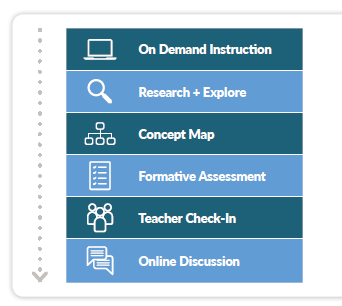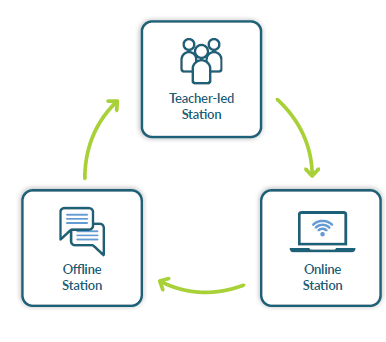OTAN News
Understanding Teacher Engagement in Blended Learning Environments
The Four Dimensions of Teacher Engagement
E-Book Written by Dr. Catlin Tucker
The direct relationship between a highly engaged student is a highly engaged teacher. “When teacher engagement dips, it has a negative effect on student engagement. When teacher engagement is high, it positively impacts both student engagement and academic achievement.” It makes sense this is true. Student engagement is “a highly researched topic in education,” in contrast, there is far less research about teacher engagement. This OTAN news item summarizes Dr. Catlin Tucker’s e-book Understanding Teacher Engagement in Blended Learning Environments, so leaders can best lead an engaged educator & support staff. This e-book has reflection questions which can easily be adopted into a staff meeting or discussion.
Introduction
Teacher engagement should be at the top of everyone’s concerns. Engagement impacts teacher turnover, feelings of self-confidence, burnout, job satisfaction, student engagement and academic performance. Because the percentage of students with access to devices increased with the Pandemic, understanding blended learning and teacher engagement go together.
What is teacher engagement?
When Dr. Tucker polled a group of educators about what words came “to mind when they heard the phrase ‘teacher engagement,’ their responses created a word cloud.” Teachers responded that engagement meant participation, connection, and learning to name a few. Dr. Tucker defines teacher engagement as “a multidimensional motivational construct that reflects a teacher’s choice to dedicate energy resources to their work.” What motivates some teachers to go beyond expectations in the classroom and others to be okay with the bare minimum?
The e-book explores each dimension of Teacher Engagement breaking each topic into sections with “specific strategies and blended learning models teachers can employ to spend more time and energy on the aspects of this work that are more cognitively, emotionally, and socially engaging.” As teachers “navigate an increasingly flexible teaching and learning landscape,” leaders must be proactive in realizing how to “re-engage teachers who may be mentally and emotionally exhausted.” To do this, “Educators must focus on setting realistic expectations, embracing sustainable workflows, and prioritizing the parts of this profession likely to yield higher levels of engagement and job satisfaction."
Cognitive Engagement
Cognitive engagement is “the degree to which teachers are attentive to and invested in their work.” If a teacher deciphers what they find cognitively engaging in their work, then this knowledge can help to 1. Evaluate where they are investing their time and energy resources, 2. Reflect on whether those tasks are energizing or draining, and 3. Adjust their approach to workflows that they find mentally draining.
The e-book suggests ensuring the person doing the learning is the student not the teacher. Dr. Tucker compares the work of a teacher to an architect. STEP 1: Both must know the people designing the learning or the structure. STEP 2: An architect sketches a blueprint, which clearly defines what the builders are working toward while a teacher must identify learning outcomes for designing a lesson or unit with intentionality. STEP 3: Position the Learner to Do the Work. An architect does not construct the building. Similarly, a teacher “Must strive to design student-centered learning experiences that challenge the students to think, discuss, problem-solve, collaborate, question, create, and reflect."
Grading student work for most teachers is the most time-consuming task beyond the running of a classroom. Deciding what to grade can be a huge time and energy saver. Dr. Tucker suggests positioning the learner as the “active agent in the experience.” For more information and for a flowchart on deciding what to grade, page 8 offers a more detailed explanation.
At the end of each section of the e-book are Reflect and Discuss questions which can be helpful for conversations or staff professional learning. Here are a few included here:
What aspects of your work do you find cognitively engaging? Why do you enjoy these tasks?
What barriers exist that make it challenging to invest your time and energy that you find cognitively engaging?
Emotional Engagement
Emotional Engagement “encompasses a teacher’s feelings about, degree of dedication to, and emotional response to their work.” A teacher’s emotional energy directly 1. Impacts their desire and willingness to invest energy into their work. 2. Affects the quality of their relationships with students 3. Benefits the overall health of the learning community.
“Two main factors can have a significant impact on a teacher’s emotional engagement at work.” They are: 1. The quality of relationships with students 2. Student behavior and classroom management. This section lends itself to strategies for improving the quality of a teacher’s relationship with their learners. Of the many ideas presented in this section, the Station Rotation Model and Playlist both represent ideas which can be used by adult learners.
The Station Rotation Model produces time for teachers to work with small groups of students. This can lead to “differentiated direct instruction,” “Interactive modeling sessions,” “small group practice and discussions,” and for “focused, actionable feedback on work in-progress.”
Credit: Dr. Catlin Tucker’s e-book (Page 12)
The Playlist Model, “presents a sequence of elearning activities that student's self-pace through to reach a desired outcome.” This model builds opportunities for teacher check-ins or conferencing. In personalizing the “learner’s path by adding or modifying learning activities, this can support and scaffold” as needed.

Credit: Dr. Catlin Tucker’s e-book (page 13)
Some Reflect & Discuss questions from this section are as follows:
What do you find emotionally engaging about your work? When do you feel the most dedicated to and satisfied with your work? What specific strategies, routines, and norms can improve your emotional engagement at work?
Social Engagement with Students
Social engagement with students is the “effect of teachers’ relationships with students on their feelings of vigor or exhaustion at work. It is critical to understand how a teacher’s social engagement with students 1. Impacts their energy levels at work 2. Strengthens their relationships with learners 3. Builds stronger learning communities.”
“When teachers design learning experiences using the different blended learning models (e.g., station rotation, playlist, or flipped classroom), they create more time to sit with learners to understand their specific needs and provide personalized support.”
Highlighted strategies include:
- Real-time Feedback Using the Station Rotation Model where a teacher shares focused, real-time feedback realizing the short amount of time and keeping on-task with a routine place for capturing their questions in a digital document.
- Side-by-side Assessments Using Choice Boards or a Playlist. This approach is a conversation and creates “transparency” about the grading process.
- Conferencing Ideas & Template
Some Reflect & Discuss questions from this section are as follows:
How does the quality of your relationships with others at work impact your energy levels or feelings of exhaustion? How can you build strong relationships with others to make your work more enjoyable and rewarding?
Social Engagement with Colleagues
The relationship between coworkers “has a direct impact on their feelings of engagement at work. As a result, it is critical to understand how a teacher’s social engagement with colleagues 1. Inspires their work and increases their willingness to try new teaching techniques. 2. Validates their hard work and unique contributions to the school community 3. Supports them both professionally and personally in the face of challenges.”
The connection between coworkers makes teachers stronger. Time spent “designing learning experiences, sharing best practices, troubleshooting issues, and accessing support” all creates a better work environment.
Some tips for Creating Time for Connection on Campus
- Coffee with Colleagues: Dedicating the first or last 15 minutes of a staff meeting to conversation.
- Snaps Jar in the Staff Room: Appreciative notes, thank Yous and/or being kind on a tough placed in a jar or box. At the end of the month, a designated person distributes the notes to the teacher’s mailbox.
- Wednesday Walks: Teachers are relieved to walk into other classrooms to observe a strategy.
- Host an Unconference: Teachers provide informal professional learning for their colleagues
- PLCs (Professional Learning Community) and the 5Es Instructional Model: Structure time and agency using Professional Learning Communities structured with a 5 E model.
“The time school leaders invest in helping to develop a strong learning community on campus characterized by teachers who feel connected and supported by one another pays dividends in terms of teacher engagement and job satisfaction."
Some Reflect & Discuss questions from this section are as follows:
What barriers make it challenging for you to connect during the day? What structures or routines are currently in place to encourage conversations and collaboration amongst your staff?
Understanding the factors which impact teacher engagement are keys to retaining higher quality teachers in an era of shortages and attrition.


